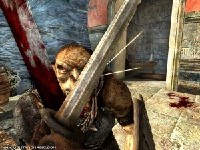| |
Site Navigation
Main
News
Forums
Games
Games Database
Top 100
Release List
Support Files
Features
Reviews
Previews
Interviews
Editorials
Diaries
Misc
Download
Gallery
Music
Screenshots
Videos
Miscellaneous
Staff Members
Privacy Statement
|
|
The subject of this week's developer blog is the editor. While not specifically talking about how the casual user will be able to work with it, the blog gives a certain degree of information about how the developers use it to create the game. Josh Glavine, content designer, is the author of this week's installment: Once we have all the boring setup out of the way, we will start using the editorís height map manipulation tools to set down a rough layout of the level. It is important to create a rough layout that satisfies our previously established goals for the level before we start adding detail. As I said earlier, adding too much detail at an early stage can leave us with areas of the level that feel poorly designed or out of place in the overall layout of the world. The Titan Quest tools allow us to create detailed environments from rolling hills to towering mountains and everything in between, but we have to make sure that what we create reflects the overall vision for that level. After the rough layout is finished, we play our levels in game and run through them to make sure that the general layout follows our plan. This also gives us an idea of the actual in-game size of the level and how it will flow for the player. Once we are satisfied that our rough layout meets the guidelines that we set up in our planning stages, we go back into the editor and start adding detail. This is when all the magic happens and our planning and inspiration really start to pay off as the level comes to life.
Read the rest here. | | Source: TQ Vault |
|
|





 Titan Quest Developer Blog #9 @ TQ Vault
Titan Quest Developer Blog #9 @ TQ Vault